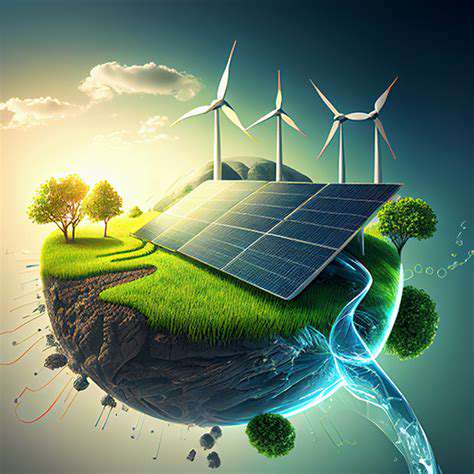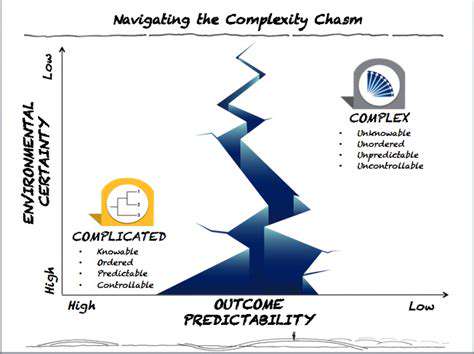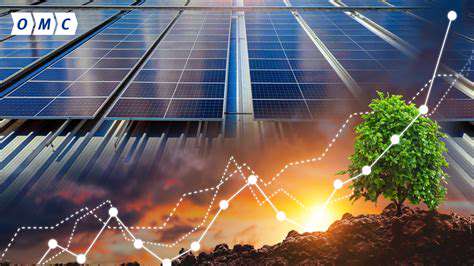Debunking Myths About Renewable Energy

The Illusion of Predictability
When people think about renewable energy sources like solar and wind, they often picture unpredictable power surges and drops. This perceived unreliability creates hesitation in adopting these technologies widely. But this view doesn't tell the whole story. While weather patterns do affect energy output, we're getting much better at predicting and managing these variations through advanced forecasting and grid management techniques.
Today's forecasting models have reached remarkable accuracy, giving grid operators precise predictions about renewable energy production. When combined with increasingly sophisticated energy storage solutions, these tools help maintain steady power delivery despite nature's fluctuations.
Technological Breakthroughs
Energy storage technology has made incredible strides in addressing renewable energy's variability. Battery systems, pumped hydro storage, and other innovative methods now store excess energy efficiently and release it when needed, smoothing out the natural ebbs and flows of solar and wind generation.
These technological leaps are transforming renewables from alternative energy sources into foundational components of reliable power grids.
Smarter Grid Solutions
Modern power grids are evolving to handle renewable energy's unique characteristics. Smart grid technology, equipped with real-time monitoring and automated control systems, can adjust energy flow instantly to accommodate changing generation patterns.
These intelligent networks are proving essential for maximizing renewable energy use while keeping electricity supplies stable, even during periods of variable generation. This adaptability represents a crucial step toward widespread renewable adoption.
Storage: The Missing Link
Advanced energy storage acts as the critical bridge between intermittent renewable generation and constant electricity demand. Modern storage solutions do more than just hold surplus energy - they provide essential stability against unexpected drops in renewable output.
Managing Energy Demand
Aligning electricity use with renewable generation patterns offers another solution to intermittency challenges. Smart home technologies and industrial energy scheduling can shift demand to match periods of abundant renewable generation.
Proactively managing consumption reduces strain on the grid when renewable output decreases while offering energy savings and environmental benefits.
Policy's Pivotal Role
Government initiatives significantly influence renewable energy adoption through financial incentives and supportive regulations. Tax benefits, subsidies, and favorable policies encourage investment in technologies that enhance grid flexibility and reduce fossil fuel dependence.
These policy frameworks foster innovation and ensure renewable energy becomes an enduring part of our energy landscape.
Addressing the Cost Concerns: Unveiling the True Economic Picture

Root Causes of Rising Costs
Cost increases across industries stem from complex, interconnected factors. Global supply chain disruptions, driven by geopolitical tensions and unexpected events, dramatically affect production expenses and delivery timelines. These impacts ripple through entire supply networks, influencing everything from material sourcing to final product distribution. Understanding these underlying dynamics is essential for developing effective cost-control strategies.
Additionally, while technological advancements typically improve efficiency, they can introduce unanticipated expenses. Implementing cutting-edge systems often requires substantial initial investments that may exceed projections. Businesses must carefully evaluate long-term benefits against short-term costs to ensure worthwhile returns.
Alternative Cost-Saving Approaches
Companies facing cost pressures should explore multiple strategies. This involves scrutinizing all operational aspects - from purchasing to production - to identify savings opportunities without sacrificing quality. Supplier evaluation and strategic negotiations represent crucial components of this process.
Process optimization offers another valuable approach. Identifying and eliminating production bottlenecks can significantly reduce waste. Implementing lean methodologies often yields substantial long-term savings. This optimization requires detailed process analysis to uncover hidden inefficiencies.
Technology's Cost-Control Potential
Modern technologies provide powerful tools for cost management. Automation and robotics can dramatically cut labor expenses while boosting efficiency in high-volume production. These technologies deliver lasting savings while improving quality and consistency. Advanced analytics offer valuable insights into cost drivers, enabling targeted reduction strategies.
Cloud computing presents another cost-effective solution. Businesses can reduce infrastructure expenses while accessing scalable computing power without major upfront investments. This approach particularly benefits startups and small companies seeking to minimize initial capital outlays.
Regulatory Impacts
Government policies significantly influence business costs. Environmental regulations, tax incentives, and subsidies all affect operational expenses. Understanding these policies helps companies navigate complex regulatory environments. Anticipating regulatory changes proves critical for maintaining compliance and avoiding unexpected costs.
Labor regulations also directly impact expenses. Proactive planning helps organizations adapt to changing employment laws. This forward-looking approach enables businesses to stay ahead of evolving economic and regulatory conditions.
Market Dynamics
Market forces like material price fluctuations and shifting consumer demand substantially affect costs. Monitoring these trends helps businesses make informed decisions about inventory and production planning. Proactive supply chain management and price hedging help mitigate external impacts. Competitor analysis informs strategic pricing and cost optimization decisions.
Economic downturns reduce consumer spending, affecting product demand. Companies must adapt strategies to remain competitive during challenging periods, potentially adjusting production, exploring new markets, or implementing cost reductions.
Examining Land Use Impacts: A Balanced Perspective
Land Use Complexities
Land utilization represents a critical consideration in renewable energy development. Understanding the relationship between renewable projects (like solar farms and wind installations) and existing land uses is essential. This requires evaluating potential ecological and social impacts, including habitat effects, agricultural land conversion, and visual considerations.
Large-scale renewable projects often require substantial land areas, raising important questions about balancing energy production with other land uses. Thoughtful site selection, environmental protection measures, and community engagement help achieve balanced solutions.
Environmental Considerations
While crucial for climate change mitigation, renewable energy carries environmental impacts. Assessing full lifecycle effects - from material sourcing to decommissioning - is essential. This includes evaluating water use, emissions, and potential habitat disruption for various renewable technologies.
Comprehensive environmental assessments help minimize negative consequences. These evaluations should account for unique ecosystem characteristics and potential long-term effects, guiding effective mitigation strategies.
Community Impacts
Renewable projects significantly affect local communities. Potential benefits include job creation and economic development, while challenges might involve infrastructure impacts and livelihood changes. Meaningful community engagement ensures projects benefit all stakeholders.
Understanding potential displacement, property value changes, and community disruption is vital. Thorough social and economic analysis helps implement equitable, beneficial renewable projects.
Technology Comparisons
Different renewable technologies present distinct land use challenges. Solar, wind, and hydropower each affect local environments differently. Comparing these impacts helps make informed decisions about technology selection and siting.
Considerations include habitat fragmentation, water use, and noise effects. Holistic technology comparisons optimize land use and maximize benefits.
Innovative Land Solutions
Integrating renewables with existing land uses can minimize impacts. Examples include combining solar panels with agriculture or siting wind turbines on underutilized land. Creative approaches to land planning are essential.
Exploring synergies between energy production and other land uses offers promising solutions. Agrivoltaics (combining solar with farming) and wind-grazing combinations demonstrate innovative possibilities for sustainable land use.
Therapeutic environments are transforming through immersive technologies like VR and AR. These digital spaces create unprecedented opportunities for personalized therapeutic experiences. By designing controlled, interactive environments, therapists enable patients to safely address challenges while developing effective coping mechanisms. The flexibility of these digital spaces allows real-time observation and adjustment of therapeutic interventions, offering advantages traditional methods can't provide.
Debunking the Job Displacement Narrative: A New Era of Employment

The Displacement Myth
The common fear of mass job losses from technological progress often stems from exaggerated claims and future work anxieties. While automation and AI certainly transform certain sectors, the idea of universal job elimination oversimplifies reality. Viewing technology as an employment catalyst rather than threat better reflects its actual role in evolving job markets and creating new opportunities.
Historical industrial revolutions show that while technology initially displaces some workers, it ultimately creates more jobs and improves living standards. This pattern will likely continue with current advancements. The solution lies in workforce adaptation through education and training for emerging roles.
The Changing Nature of Work
Work continuously evolves - this isn't new. Throughout history, technological progress has transformed jobs, requiring workers to adapt to new tools and processes. While these transitions create anxiety, they ultimately lead to more complex roles requiring different skills.
Current technological changes follow this pattern. While automation may replace some jobs, many others will transform, blending human creativity with technical skills. This evolution demands proactive reskilling to meet modern job market needs.
Adaptability as the Key
Success in today's job market requires adaptability. Workers must embrace continuous learning to stay competitive. Educational institutions and employers play crucial roles by providing relevant training for technology-driven workplaces.
This approach ensures smoother transitions for displaced workers while strengthening the economy through a more skilled workforce.
Policy Support for Transitions
Government policies can significantly ease job displacement impacts. Investments in STEM education and training prepare workers for future job demands. Income support and retraining programs help displaced workers find new opportunities, creating a more resilient workforce.
Policies encouraging entrepreneurship and new business development stimulate economic growth and job creation. Supporting innovation helps workers not just adapt to changes but participate in creating new industries.
A Comprehensive Approach
Addressing job displacement concerns requires multifaceted solutions considering both worker and employer needs. Technology itself isn't the enemy - it's a driver of change. Focusing on reskilling and adapting to evolving job markets ensures smooth transitions and creates a more productive, inclusive economy.
Successful navigation requires collaboration between governments, educators, businesses, and individuals. Working together, we can prepare workers for the future and ensure technology empowers rather than displaces the workforce.
Beyond the Basics: Exploring the Integration of Renewables
Realistic Cost Assessment
While renewable energy offers long-term savings, honest discussions must acknowledge substantial upfront infrastructure costs. These include grid upgrades, transmission improvements, and initial technology investments. Comprehensive evaluations must consider total lifecycle costs - both installation and maintenance expenses.
Additionally, energy price volatility and renewable intermittency require careful planning and storage solutions to ensure reliability. Ignoring these complexities leads to unrealistic cost projections.
Solving Intermittency Challenges
Solar and wind power's variable nature presents grid stability challenges. Effective solutions require smart grids, energy storage, and demand-response programs working together.
Storage technologies like batteries and pumped hydro store excess energy during peak production for use during high demand, ensuring consistent power availability.
Policy's Influence
Government incentives significantly accelerate renewable adoption. Tax credits, subsidies, and favorable tariffs reduce installation costs, improving competitiveness with fossil fuels.
Supportive policies streamline permitting and create positive regulatory environments, encouraging investment and speeding the transition to cleaner energy.
Environmental Balance
While renewables generally have smaller environmental footprints than fossil fuels, their production and implementation still create impacts. Solar panel manufacturing requires specific materials and energy, while component disposal needs careful management.
Community Considerations
Renewable projects must address local community needs and concerns. Development should minimize environmental and community impacts, including visual, noise, and ecosystem effects.
Open communication and community involvement foster public acceptance and smooth project integration.
Grid Modernization Needs
Traditional power grids designed for centralized generation require significant upgrades to handle distributed renewable energy. Improvements include transmission upgrades, smart grid implementation, and enhanced management systems to accommodate renewable variability.
Innovative Applications
Renewable energy applications extend beyond electricity generation. Emerging uses in transportation, heating, and cooling demonstrate renewable energy's expanding role.
Electric vehicles, solar heating systems, and biofuel transportation represent just a few examples of renewable energy's growing versatility.


